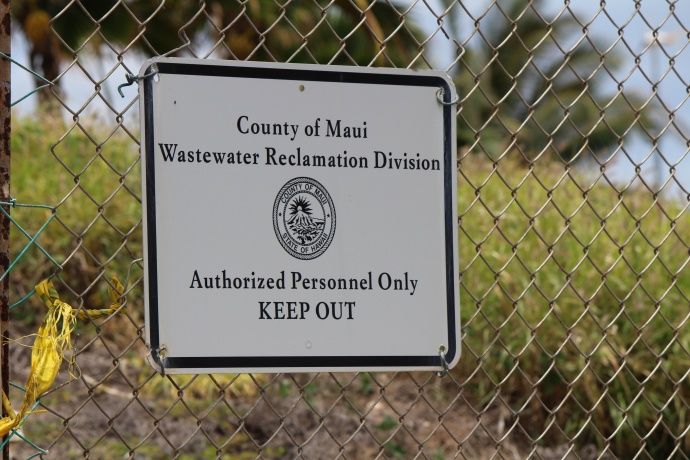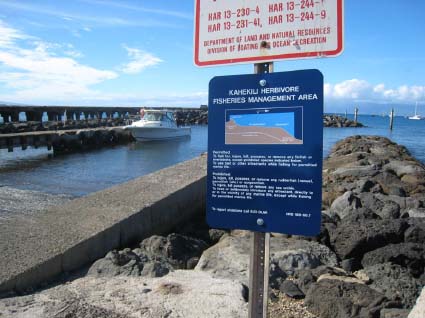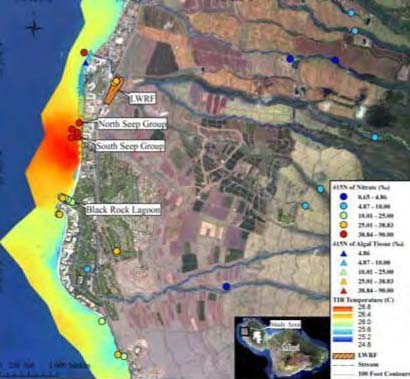EPA Weighs in on Lahaina Injection Wells in West Maui

Wastewater Reclamation Facility sign, Maui. File photo by Wendy Osher.
The US Environmental Protection Agency filed an amicus brief in a case before the US Court of Appeals for the Ninth Circuit involving the use of injection wells to dispose of treated sewage at the County of Maui’s Lahaina Wastewater Reclamation Facility.
Earthjustice, an environmental law firm representing four Maui community groups sued the County in 2012, seeking to protect the sensitive coral reefs at Kahekili. The lawsuit was filed on behalf of the Hawaiʻi Wildlife Fund, Surfrider Foundation, Sierra Club-Maui Group, and West Maui Preservation Association.

Signs are posted along areas protected in the Kahekili Herbivore Management Area. File photo courtesy Division of Aquatic Resources.
Firm representatives maintain that the Lahaina facility injects 3 million to 5 million gallons of treated sewage into groundwater each day and filed the suit in an effort to protect public users of the popular beach park from what they called “harmful pollution.”
In 2011, an EPA-funded study used tracer dye to link the Lahaina wastewater flows to groundwater in near-shore waters off Kahekili Beach in West Maui. Earthjustice says the flows have been linked to algae blooms that “smother the coral reefs and other degradation of this unique marine ecosystem.”
An agreement was reached in 2015, requiring the county to come up with “safer ways” to dispose of wastewater at its Lahaina Wastewater Reclamation Facility. The agreement settled the penalty phase of the lawsuit, but at the time, the County expressed a plan to appeal lower court rulings relating to the case.

ES-6: Infrared SST showing values of terestrial and marine waters, and the intertidal macroalgae. Image courtesy Tracer Study report conducted by UH for state DOH, and US EPA. Access to report provided by Earthjustice.
Last year, the County appealed the US District Court in Honolulu’s decision that use of the injection wells violates the federal Clean Water Act.
Earthjustice staff attorney David Henkin released a statement today saying, “We are pleased the EPA has joined us in fighting Maui County’s illegal use of the Lahaina injection wells. As EPA’s amicus brief makes clear, the County cannot avoid the Clean Water Act’s requirements by using the groundwater beneath the Lahaina facility as a sewer to channel treated sewage to the ocean.”
Today, the County responded to the latest development. Maui Corporation Cousel Patrick Wong responded to our request for a statement saying, “The 9th Circuit is currently reviewing this ruling and as usual, Mr. Henkin seeks to influence their opinion through the use of inflammatory comments.”
“The fact of the matter is that the injection wells were permitted by both the state Department of Health and the EPA,” said Wong. “In fact the EPA states on their own website that injection wells have proven to be a ‘safe and inexpensive option’ for many fluids including wastewater. The only question is whether an injection well causes a ‘public water system to violate drinking water standards or otherwise adversely affect public health.'”
Wong continued saying, “The federal court’s ruling only stated that the Lahaina injection wells treated wastewater did reach the ocean, not that it was affecting public health. We hope that the 9th Circuit makes that distinction as well.”
According to information compiled by Earthjustice, the EPA’s amicus brief emphasizes that “exempting discharges through groundwater could lead to absurd results.”
The agency agreed with another court that noted “it would hardly make sense for the [Clean Water Act] to encompass a polluter who discharges pollutants via a pipe running from the factory directly to the riverbank, but not a polluter who dumps the same pollutants into a man-made settling basin some distance short of the river and then allows the pollutants to seep into the river via the groundwater.”
According to th environmental law firm, “The EPA reiterated the agency’s ‘long-held position’ that, to protect our Nation’s waters, the Clean Water Act ‘requires permits for discharges of pollutants that move to jurisdictional surface waters’—here, the Pacific Ocean off Kahekili Beach—’through groundwater with a direct hydrological connection.'”
“Because the County failed to secure the required permit and comply with permit terms necessary to protect water quality, its use of the injection wells is illegal,” according to an Earthjustice press release.
The law firm further stated that, “the EPA’s amicus brief makes clear that the County had ample notice a Clean Water Act permit is required, both because of the Act’s plain language and through direct communications from the EPA to the County raising concerns about Clean Water Act violations at the Lahaina facility.”









